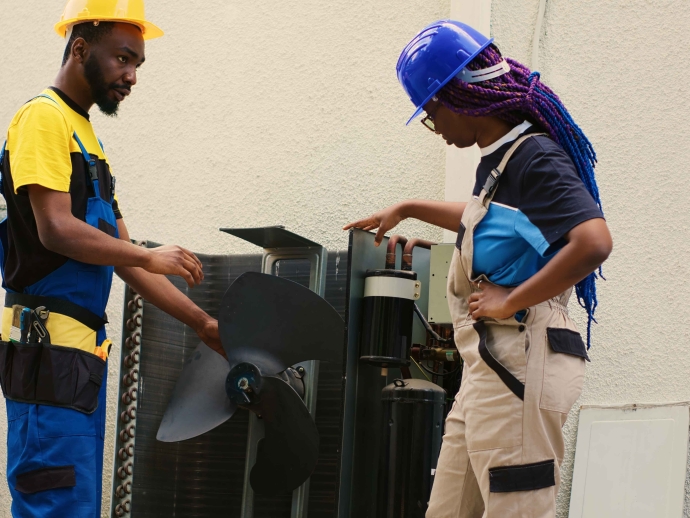Year-Round Energy Savings: Seasonal HVAC Efficiency Tips for Texas Weather

In Texas, where the climate can vary dramatically from scorching summers to chilly winters, managing energy consumption for heating, ventilation, and air conditioning (HVAC) systems is crucial. Implementing seasonal HVAC efficiency tips can help homeowners reduce energy costs while maintaining a comfortable indoor environment year-round. This article provides practical strategies tailored to Texas weather conditions, ensuring that your HVAC system operates efficiently throughout the seasons.
Spring: Preparing for Warmer Months
As temperatures begin to rise in spring, it's essential to prepare your HVAC system for the upcoming heat. Here are some tips to enhance efficiency during this transitional season:
-
Clean or Replace Air Filters: Clogged air filters restrict airflow and force your HVAC system to work harder. Check and replace or clean filters monthly, especially during peak usage months. This simple maintenance task can significantly improve system efficiency and indoor air quality.
-
Schedule Professional Maintenance: Spring is an ideal time for a professional HVAC check-up. A technician can inspect the entire system, clean components, and identify any potential issues before they escalate. Regular maintenance not only extends the lifespan of your equipment but also ensures optimal performance.
-
Upgrade to a Programmable Thermostat: A programmable thermostat allows you to set different temperatures for different times of the day. For instance, you can program it to raise the temperature while you're away at work and cool down just before you return home. This feature helps reduce energy consumption without sacrificing comfort.
-
Seal Air Leaks: Inspect windows, doors, and ductwork for air leaks that can lead to energy loss. Use weatherstripping or caulking to seal gaps and cracks, ensuring that conditioned air remains inside your home.
Summer: Maximizing Cooling Efficiency
Texas summers can be brutal, with temperatures often exceeding 100°F. To keep your home cool while minimizing energy costs, consider the following strategies:
-
Optimal Thermostat Settings: Set your thermostat to around 78°F when you're home and increase it by 7-10 degrees when you're away. This adjustment can lead to significant energy savings without compromising comfort.
-
Utilize Ceiling Fans: Ceiling fans create a wind-chill effect that makes you feel cooler without lowering the room temperature. Running ceiling fans in conjunction with your air conditioning allows you to raise the thermostat setting by a few degrees while maintaining comfort.
-
Close Curtains and Blinds: During the hottest part of the day, close window coverings to block direct sunlight from heating your home. Consider using blackout curtains or reflective window films to enhance energy efficiency.
-
Shade Your Outdoor AC Unit: If your outdoor unit is exposed to direct sunlight, it has to work harder to cool your home. Planting trees or installing awnings can provide shade and improve efficiency by up to 10%.
Fall: Transitioning to Heating Mode
As temperatures drop in the fall, it's time to prepare your HVAC system for heating:
-
Inspect and Clean Ducts: Before switching from cooling to heating, ensure that your ductwork is clean and free from obstructions. Dust and debris can accumulate over time, restricting airflow and reducing efficiency.
-
Check Heating Components: Schedule a professional inspection of your heating system before winter arrives. A technician can check components such as burners, heat exchangers, and blowers to ensure they are functioning correctly.
-
Adjust Thermostat Settings: Similar to spring settings, consider programming your thermostat to lower temperatures at night or when you're away from home during fall months.
-
Add Insulation: Ensure that attics, basements, and crawl spaces are properly insulated to minimize heat loss during cooler months. Adding insulation can significantly improve energy efficiency and comfort levels.
Winter: Ensuring Efficient Heating
During winter months in Texas, maintaining an efficient heating system is essential:
-
Maintain Optimal Temperature Settings: Keep your thermostat set at a comfortable level (around 68°F) during the day while lowering it at night or when you're away from home.
-
Utilize Space Heaters Wisely: If you have rooms that are seldom used, consider using space heaters instead of heating the entire house. However, ensure that these heaters are energy-efficient and used safely.
-
Regular Maintenance Checks: Schedule regular maintenance checks during winter months to ensure that your heating system operates efficiently throughout the colder season.
-
Monitor Indoor Air Quality: Winter can lead to dry indoor air due to heating systems running continuously. Consider using humidifiers or placing water basins near heat sources to maintain comfortable humidity levels without overworking your HVAC system.
Common Mistakes to Avoid
While implementing seasonal HVAC efficiency tips can lead to significant savings, there are common pitfalls homeowners should avoid:
-
Neglecting Regular Maintenance: Skipping routine inspections can lead to unexpected breakdowns and costly repairs down the line.
-
Ignoring Air Filter Changes: Failing to change air filters regularly restricts airflow and forces the system to work harder than necessary.
-
Overlooking Insulation Needs: Proper insulation is crucial for energy efficiency; neglecting this aspect can lead to significant heat loss during winter months.
-
Setting Thermostats Too Low or High: Extreme thermostat settings can strain HVAC systems; aim for moderate adjustments instead.
Conclusion
By implementing seasonal HVAC efficiency tips tailored specifically for Texas weather conditions, homeowners can enjoy year-round comfort while significantly reducing energy costs. From regular maintenance checks and optimal thermostat settings to sealing air leaks and upgrading insulation, these strategies will help ensure that your HVAC system operates efficiently throughout every season.
As climate conditions continue to evolve, adopting these best practices not only enhances comfort but also contributes positively toward sustainability efforts in our communities—making it a win-win situation for both homeowners and the environment alike.

